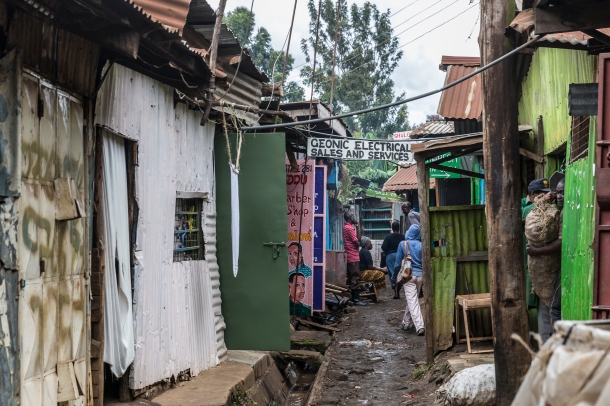Privation, Poverty, Disease
"We can't effectively mitigate the growing problem of antibiotic resistance without dealing with places like Kibera [Kenya]."
"There are a billion people living in similar situations, and as long as they aren't getting clean water and basic sanitation, all of us are at risk."
Dr. Guy Palmer, researcher, Washington State University
"We are quickly running out of treatment options."
"If we don't get a handle on the problem, I fear for the future."
"[Nearly 70 percent of salmonella infections in Kenya had stopped responding to the most widely available antibiotics, up from 45 percent in the early 2000s.] Salmonella kills roughly 45,000 Kenyan children every year, or nearly one in three who fall severely ill with it. [In the United States, the mortality rate is close to zero]."
Dr. Sam Kariuki, researcher, Kenya Medical Research Institute
"Who am I to deny them what they want?"
"Even when I manage to sell the whole box [full course of antibiotics], my customers rarely take them all because they think it's just too many pills."
Lena Ochomba, 40, pharmacy stall owner, Kibera
 |
| Kibera slum alley (photo via Flickr/Ninara) |
We hear and read about the rise of antibiotic-resistant pathogens and microbes, the result of too-frequent and inappropriate use of antibiotics leading to the pathogens' resistance as a result of genetic alterations. Hospitals in the West are on their guard and take whatever steps they can to try to ensure that the resistant strains of deadly pathogens are kept in check, taking extraordinary measures to cleanse areas known to shelter the bugs.
Health professionals are being told to stop prescribing antibiotics needlessly. Public relations efforts to persuade people not to make common use of such household products as antibacterial soap have seen those products disappearing from supermarket shelves. People are being educated that viruses are not a cause for antibiotics to cure. Antibiotics are used for bacterial infections; careless use results in rapid replication and new antibiotic resistant bacterial strains.
In poor countries of the world, particularly in Africa, antibiotics, the one-time miracle cure, are now widely available, at low cost. India and China are churning out inferior-grade antibiotics sold cheaply, and many in poor slum areas believe in their miraculous curative powers. They commonly visit their village pharmacist who, in many instances has no pharmaceutical academic background, but who acts as a health professional, confidently making diagnoses and prescribing antibiotics.
Resistant pathogen claim 700,000 lives worldwide yearly, according to a British study. In Kenya resistance has resulted from lack of effective treatment and each year young children whose immune systems have not yet developed fully fall victim. Close to 70 percent of salmonella infections in Kenya no longer respond to the most widely available antibiotics; that number in 2000 was 45 percent.
One in three Kenyan children who become severely ill with salmonella will die of it. Antibiotic vendors tend to sell counterfeit antibiotics sometimes containing none of the active ingredient, or so diminished in content they end up accelerating resistance. And even when drugs are authentic poor Kenyans count on saving money by buying a few tablets rather than a full course; insufficient to fight an infection, yet enough to permit bacteria to mutate and gain resistance.
In a small slum village outside Nairobi, the Kenyan capital, human waste in Kibera courses through shallow latrines and roadways running between homes, sitting in pools. Plastic bags filled with feces are thrown from rooftops at night onto the street; these are termed 'flying toilets' by residents too frightened to venture out at night to dispose of them otherwise.
Children play in the streets, in the fecal muck: "They are kids, they will always go outside to play" said one young mother. "How can you stop them?" Public health officials and epidemiologists who study Kibera speak of the direct link between the community's absent hygiene and infections that break out in every house where harmful feces bacteria seep into the soil, surviving for months in the densely populated settlement's dirt paths.
The bacteria get into food and water; residents carry the pathogens into their homes on shoes or their unwashed hands. The U.S. Centers for Disease Control and Prevention in a 2012 study identified cases of typhoid fever among Kibera children; 15 times more prevalent than for those living in a rural area west of the capital. And of the typhoid strains found in Kibera, 75 percent were resistant to commonly available antibiotics.
"A lack of sanitation leads to more disease, which leads to higher antibiotic use, which leads to greater resistance. It's a vicious cycle", commented Marc Alain Widdowson, principal deputy director of the CDC's Division of Global Health Protection for Kenya. "It's in the soil. It's on the kale people eat, and also on the hands of adults and children. It's no wonder people here are constantly sick", stated Sylvia Adhiambo Omulo, researcher at Washington State University's global health program in her years studying antimicrobial resistance in Kibera, stunned by the ubiquity of resistant pathogens such as E.coli.
Labels: Antibacterial resistance, Bacterial Infections, Child Welfare, Hygiene, Kenya, Poverty, Sanitation

<< Home